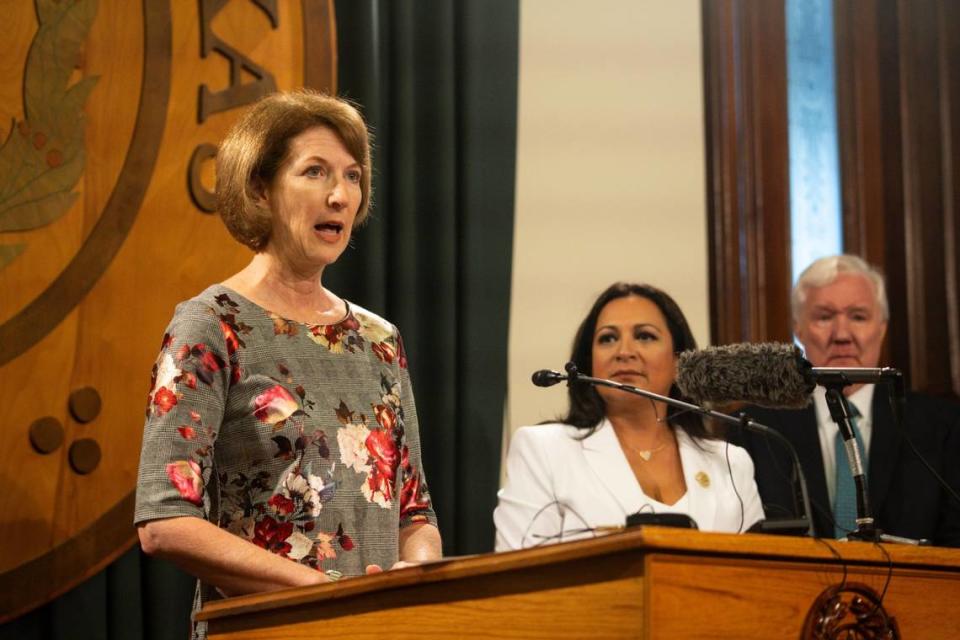We need more women running for Texas Legislature. First step: higher pay | Opinion
In 2020 and 2022, talk of a “blue wave” in Texas pushed out discussion of gender parity in our government. This was disappointing. The share of women holding judgeships decreased to just under 40%, and in the Legislature, it’s 29.8%
Our government is grappling with increasingly complex issues, and our laws are better when they’re informed by life experiences that vary across genders, cultures and backgrounds. Research in the hard sciences, social sciences, and humanities demonstrate the positive impact of diverse representation — it helps identify more problems and it scrutinizes proposals from more vantage points.
We should see more women running for office and winning. Texas women are active politically. They vote. In the 2020 presidential election, 6.3 million Texas women voted, compared with 5.6 million men. Media attention on women candidates is generally plentiful and positive. Political parties are supporting women candidates.
The Lone Star Parity Project showed that in 2022, 47% of the Democrats who filed to run for office were women, compared with 34.5% of Republicans. In the end, 11.6% of winning candidates were Democratic women, and 31% were Republican women.
Some point to the number of filings as signs of a confidence gap, that women will not jump into a campaign without thorough preparation that can take years: committee work, endorsements, contributors, training, etc. Maybe, but a 2021 study at the Center for Women in Government at Texas Woman’s University showed otherwise. We surveyed women officeholders, and more than expected said they hopped into a campaign with less than a year’s consideration. A confidence gap may exist, but other barriers may be at play.
People are rational when deciding to run for office, and pay and workload may be institutional barriers. Women responding to our survey were more likely than their male colleagues to identify the cost of running for office and the work of caring for family as impediments that initially kept them from running; women also identified missing work as a problem.
These concerns in turn affect which offices attracted candidates. Women aspiring to higher office in our survey generally listed county office, judicial office or Congress; very few mentioned the Legislature, a natural step up from local office. In our survey, 50% of the women who marked caring for family as a barrier ultimately ran for and won city office, with 38% choosing county office and 12% choosing judicial office. The women concerned primarily about missing work similarly ran for county (51%), city (31.5%), and judicial (17%) offices. County and judicial positions are local campaigns where officeholders serve locally and receive professional pay.
Why might these and other women avoid the Legislature? It’s rational. In Texas, we designed a Legislature with two disadvantages: We pay extremely little and expect a lot of work.
This is not the case with other elected offices. The Texas Association of Counties shows full-time county officials are paid anywhere from $40,000 to $198,000 a year. They work in their home county without constant travel to the Capitol. Women are better represented in these offices, especially as clerks and treasurers. There are also more women in the court system, where district judges earn between $140,000 and- $168,000 a year, also relatively close to home.
In comparison, a lawmaker, who travels to Austin every week when the Legislature is in session, earns $7,200 a year with a $221 per diem to cover session expenses. After the legislative session, they serve their district for another 18 months, including special sessions (especially lately). So, it is in the Legislature where we still see fewer women running and serving.
Texas, with its love of local responsibility and community service, maintains a citizen legislature. By design, members are not professional politicians. Their work in Austin is only for 140 days every two years, unless special sessions are called by the governor. This encourages legislators to live and work at home, under the laws they pass. We imagine they return from Austin to a full-time job, a house down the street, and an occasional meeting with local citizen groups on the side.

The reality is that many legislators are not returning to typical full-time jobs. Our Legislature comprises mainly business owners, law partners and executives because these positions have more control over their schedules than other careers and legislative prestige has currency. Regardless of the perceived prestige of employing a state legislator, most employers cannot be that generous — school districts, stores, hospitals, manufacturers and offices need their employees at work each day, all day.
This creates a conundrum: Who can afford to win office? A salary of $7,200 per year might have worked as a secondary family income in 1975, when the median family income was $11,800. Nearly 50 years later, this salary limits who can become legislators.
The Legislature’s limited income isn’t an oversight. Voters often reject legislative pay increases. The raise from $4,800 to $7,200 came in 1975 after four failed propositions asked voters to boost salaries to a range from $8,400 to $15,000. Yet voters passed pay increases for the governor, comptroller and attorney general, each of whom now earn $153,750 a year.
Voters know the governor works year-round and grudgingly pay a reasonable wage for the expertise. But we still believe the idyllic notion that legislators only work a few months every two years. We need to compensate legislators for the time they spend out of Austin, doing constituent casework, and writing, reading, researching, and communicating about policy and laws.
As we saw in 2021, when laws needed to winterize our power grid left fuel suppliers with exploitable loopholes, our legislators need time to make decisions. The Legislature was forced to return to the issue again in 2023. If we don’t hire more professional lawmakers, they will increasingly rely on staff, interest groups and businesses to advise and help write legislation and policy.
Money is a big part of deciding to run for office. When women list financial constraints on other surveys, loss of salary is part of the financial equation, but cost of childcare and house maintenance are also listed by women who are the primary caretakers for family and home. If they cannot rely on a spouse or family member to assist, then they need to pay for assistance.
If we want more women to have the option of running, we need to think about what the job really requires. For a job that calls a legislator away from home for weeks at a time and then asks for constituency service when the legislator is home, increasing the salary by a minimum of $23,000 could make a difference.
Of the top five Legislatures with near gender parity, three have Democratic, and admittedly women are a high percentage of their Democratic candidates. But these five states also compensate their legislators better: All five legislatures meet an average of 100 to 120 days in session, while paying legislative salaries between $16,245 (Maine) and $57,876 (Washington) per year.
In Nevada, a state Legislature with gender parity, meets every two years, like Texas, and lawmakers are paid $15,600 for their 120-day session. Also important, Nevada legislators serve fewer constituents. Nevada Senate districts average a population of 142,000 while Texas Senate districts average 935,000.
If women seek to balance family, a full-time job and public service, a seat in our citizen legislature will seem an impossible reach for many, despite a heart for service. Texas is growing, and the challenges facing our Legislature are complex. If we want lawmakers with the experiences and perspectives necessary to deal with the problems that come with a $2.3 trillion economy, finding $4.1 million — roughly what we just paid to have four special sessions — in a state budget of $161 billion a year, may be a worthwhile investment.
Jennifer Danley-Scott is a faculty member in residence at the Center for Women in Government, part of the Jane Nelson Institute for Women’s Leadership at Texas Woman’s University in Denton.

Do you have an opinion on this topic? Tell us!
We love to hear from Texans with opinions on the news — and to publish those views in the Opinion section.
• Letters should be no more than 150 words.
• Writers should submit letters only once every 30 days.
• Include your name, address (including city of residence), phone number and email address, so we can contact you if we have questions.
You can submit a letter to the editor two ways:
• Email letters@star-telegram.com (preferred).
• Fill out this online form.
Please note: Letters will be edited for style and clarity. Publication is not guaranteed. The best letters are focused on one topic.

